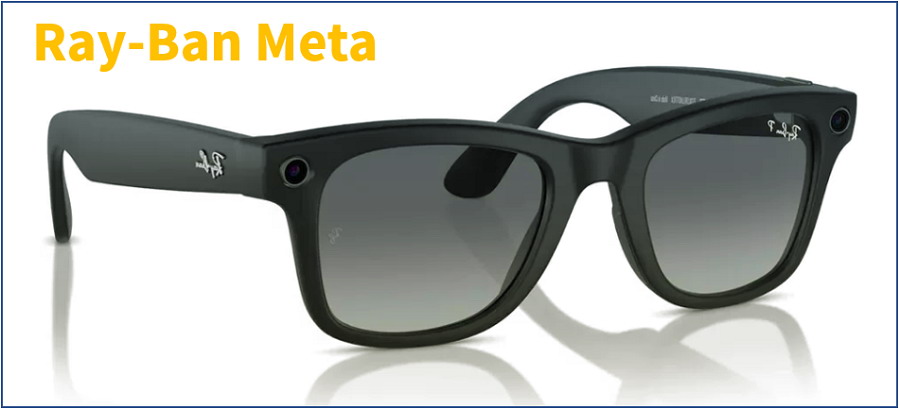I. Market Opportunity
AI glasses are based on the functions and frames of traditional glasses and are equipped with components such as cameras, acoustic modules, SoC chips, and batteries. They achieve the intelligent upgrade of the product and have the ability to access multi - modal large models. They feature light weight and offer a brand - new interaction mode.
The AI glasses are stylish in design, thus also serving as decorative items. They are portable in size and affordable in price, which strongly stimulates consumers' willingness to purchase. As a result, they have gradually become the most mainstream product among AR glasses. The market research firm IDC believes that smart rings and glasses without displays will be the most interesting wearables in the next few quarters. It is expected that more major manufacturers will enter the market in 2025. The successful model of AI glasses has already emerged, and the industry generally believes that 2025 will mark the first year of AI glasses.

Figure 1: Meta and Ray-Ban collaborated to produce over one million Ray-Ban Meta smart glasses
According to the BOM (Bill of Materials) breakdown of current products in the industry, the SoC chip accounts for a relatively high cost in AI glasses. For example, the price of the Qualcomm Snapdragon AR1 chip, which is mainstream in the market, exceeds $50, accounting for about one - third of the overall BOM cost of the device. This has also led to the high cost of AR glasses. Take the popular Ray - Ban Meta glasses in the market as an example, the starting price of its entry - level model is as high as $299 (approximately RMB 2,200).
At the Sigmastar Technology Developer Conference in 2024, Sigmastar launched the SSC309QL, a small - sized, low - power - consumption, and light - intelligent image processing chip specifically designed for the smart glasses field. With the entry of more cost - effective domestic chips into the market and the opening up of the sinking market, AI glasses are expected to experience explosive growth.
II. Key Advantages
(1) Compact Size, Flexible Design
The SSC309QL SoC chip features high integration and uses the advanced Chiplet packaging technology to reduce the chip size. Compared with the AR1 chip with an external DDR, the SSC309QL with built - in LPDDR4x reduces the PCBA footprint by 24%. Moreover, to make the glasses temples narrower, the SSC309QL adopts a non - standard elongated package design, with its width 20% less than that of the AR1. Meanwhile, in the design of the chip pins (pin out), through the system - level layout design, it can be back - to - back mounted with the eMMC chip, optimizing the chip layout and routing. This significantly reduces the requirements for the overall production process and improves the production yield. The SSC309QL can be perfectly adapted to the smart glasses scenario without taking up extra space or adding any burden to the overall glasses design. At the same time, the cost can be greatly reduced, and the production efficiency can be improved, enabling solution providers to fully unleash their creativity and create diverse and personalized smart glasses products.
(2) Excellent Image Processing, Capturing Moments
The SSC309QL uses SigmaStar's fourth - generation self - developed image processing engine, ISP4.0, which has multiple outstanding features. It has a photo - taking capability of up to 12M (12 million pixels), supports dual channels, and a series of advanced image technologies such as 3A, HDR, WDR, 3DNR, and LDC. In terms of video encoding, it can output in 4K@30 H.264/H.265 format, and can also reach a resolution of 12M in JPEG format. Whether capturing magnificent landscapes or recording daily details, it can present clear, detailed, and vivid - colored images.
Under laboratory conditions, WDR/YEE plays a key role in presenting fine details, with clarity and fineness far exceeding that of similar products, making object outlines clearly distinguishable. In scenarios with strong light - dark contrast such as street scenes and roadside areas, it has an excellent light suppression effect, avoiding halos or over - exposure in overly bright areas while ensuring that information in dark areas is not lost. The clarity, color restoration, and saturation all reach an extremely high level. Even in low - light conditions, it can meet the requirement of controllable noise and capture clean and clear images, providing users with an ultimate imaging experience. In addition, it also provides an EIS (Electronic Image Stabilization) function. Whether shooting videos while walking or recording sports moments, it can effectively reduce image shaking, making the captured images smoother and more stable, further enhancing the image quality.
(3) Ultra - Low Power Consumption, Worry - Free Battery Life
The SSC309QL adopts a modular power supply partition design, low - voltage technology, and dynamic voltage regulation technology in its design. With a streamlined function set, it reduces the quiescent current, thereby reducing power consumption. Under the condition of 2M video recording, the SSC309QL only consumes 300mW, and the overall device power consumption is only 600mW, which is 50% lower than that of the AR1. It strictly controls the power consumption within the optimal range throughout the process. Such efficient power management leads to a substantial improvement in battery life.
At the same time, the SSC309QL uses a low - power technology architecture that combines hardware and software, enabling all - day video recording. While achieving AI recognition, the power consumption is only 30mW. Calculated based on the 150mAh battery capacity of Ray - Ban glasses, in this mode, it can work for about 15 hours, basically meeting the daily usage needs without worrying about premature battery depletion, completely eliminating battery life anxiety.
(4) All - Day Intelligence, What You See Is What You Get
The SSC309QL has a built - in computing power of up to 1.5T, which can support local low - power smart applications, such as running classification and recognition models. Combined with the low - power design architecture, it can perform low - power event recording, such as recording daily activities, summarizing or reminding to take photos of the content read in books, reminding about the reading distance, and performing AI recognition and detection of specific events in specific scenarios, reminding for interaction, and taking photos or videos. For example, it can recognize people, food, scenery, pets, and specified actions, bringing users a smooth and effortless "all - day intelligence" experience.
III. Summary
CES 2025 defined its theme as “DIVE IN” (immersion), and the main theme of the exhibition revolved around “AI + everything”. AI glasses can be easily adapted to multi - modal large AI models and will lead the industry's innovation trend. According to a report from CITIC Securities, the global shipment of AI glasses was approximately 3 million pairs in 2024 and is expected to rapidly increase to around 10 million pairs in 2025. Wellsenn predicts that the global shipment of AI smart glasses is expected to reach 80 million pairs by 2030, with the global market penetration rate rising rapidly.

Figure 2: Forecast of the AI Smart Glasses Market Size
The launch of SigmaStar's SSC309QL not only represents a major technological breakthrough but also holds profound significance in terms of industry value. Through its low - power and high - integration design, the SSC309QL provides strong technical support for the development of portable devices such as smart glasses. It not only lowers the development threshold for AI glasses, enabling more enterprises to quickly enter this field but also promotes the expansion of smart glasses into a wider range of application scenarios. It inspires continuous innovation across the entire industry and drives the popularization and development of smart devices. In the future, as more innovative products based on the SSC309QL are introduced, smart devices will be more deeply integrated into people's daily lives, reshaping the human - machine interaction experience and opening a new era of smart technology.









